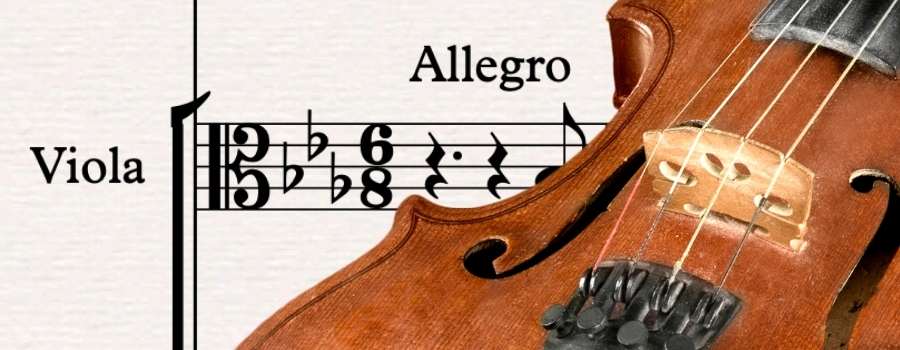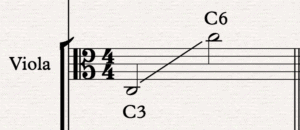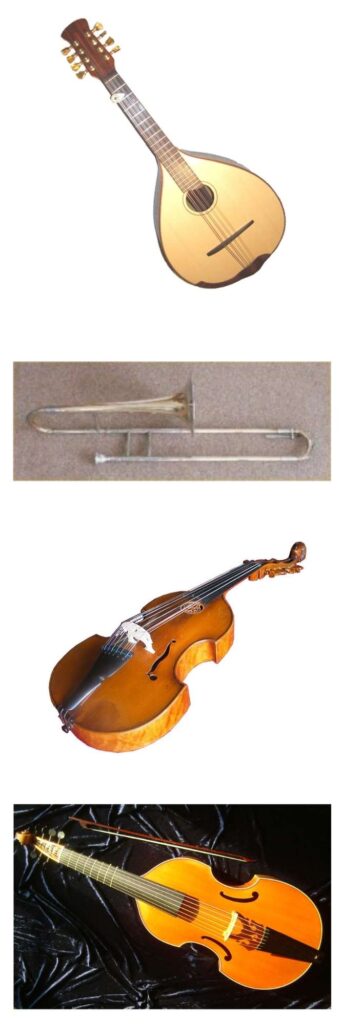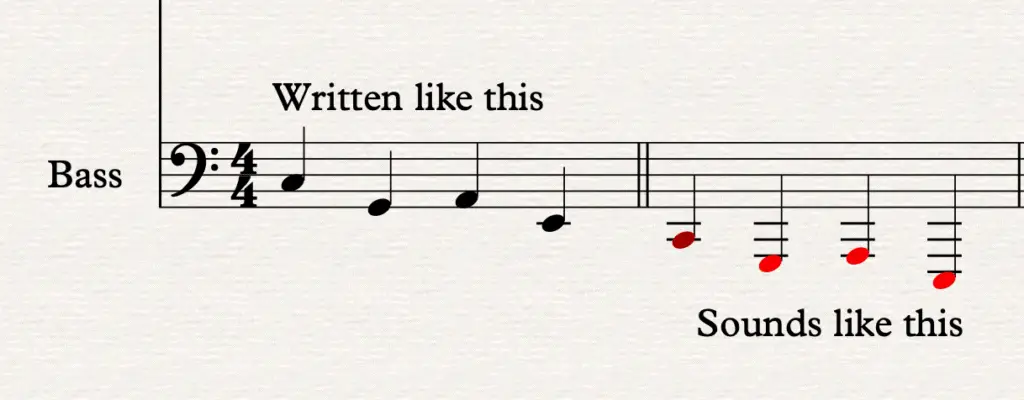
Even people who aren’t musicians will recognize the treble clef and bass clef as musical iconography…even if they don’t know what they mean. This isn’t the case for the alto clef though, as really only one instrument plays it regularly…the viola.
With the vast majority of instruments playing the treble clef and bass clef, why does the viola get its own clef…I mean, the alto clef is commonly referred to as “The Viola Clef.”
In general, violas play in alto clef because the musical range of the instrument fits more comfortably on it. If treble or bass clef were used, much of the music would have to be written using leger lines. Excessive leger lines will make the music look cluttered and could become difficult for players to read.

While the range of the viola and trying to minimize the usage of leger lines are the main reason to use the alto clef, there is also the historical printing reasons.
In addition, you may wonder if other instrument use the alto clef and if there are other clefs associated with it?
Musical Reasons
The lowest note of the viola is the “C” below middle “C” and the high end will see notes up to “C” above the treble clef.*

*The viola can play higher than this and can also utilize harmonics, but for the sake of keeping things simple, we’ll keep the range from C3 to C6.
This means that the bulk of the viola’s range will fit comfortably on the alto clef. Using the bass clef will force the use of many leger lines above the staff and treble clef will require several leger lines below the staff. It should be noted that viola sheet music will shift to treble clef if the music is written at a higher range for an extended period of time.
This means that viola players are required to know how to read both alto and treble clefs.
Historical Printing Reasons
Now, this is partially based on historical evidence of printers using shortcuts for printing books and also a little speculation on my part.
Printing was a costly endeavor back in the days of manually setting the stamps and plates. Paper wasn’t cheap and neither was ink…plus, the process was very time-consuming and lacked the precision and sharpness that digital printing has.
Having to make copies of musical parts and scores was a tedious process that would be all the more painstaking if the print setter had to ensure he put the proper amount of leger lines for a passage of music (and remember, they were setting everything backward so it would print frontwards.)
Music is already quite cluttered looking, especially conductor scores for full symphonic or opera pieces. Good layouts and clean parts have been the bane of composers and copyists/typesetters for centuries…still is, even with advanced notation software such as Sibelius, Finale, and Dorico.
While any information on when the alto clef first appeared isn’t totally clear, we know that the treble clef started showing up in music back in the 9th century. As Gregorian chant evolved and notation became more standardized, the bass clef, tenor clef, and alto clef started showing up…this was sometime between the 14th and 16th centuries, give or take a century or two.
Music in this time period would have been handwritten and only used at the monastery the monk that composed it lived in. But as music standardized and grew, printing presses started being used to mass-produce sacred music manuscripts. All of that is to say that neatness and accuracy were essential (though not perfect) to ensure time, money, and materials weren’t wasted.
Besides Viola, What Other Instruments Use The Alto Clef
While the alto clef isn’t as popular as it once was, a few instruments do still use the alto clef. Alto trombones are probably the second most popular instrument that uses the alto clef.
That’s not to say the alto trombone is a very popular instrument, but it’s still more recognizable than other instrumets that use the alto clef:
- Mandola
- Alto Trombone
- Viola d’Amore
- Viola da Gamba

Mandola
The mandola, or alto mandolin, is a string instrument with frets.
It acts as the alto voice in the mandolin family and shares a string layout with the viola, C-G-D-A.
It is mainly used in Italian and Irish folk music, however other instruments…such as the bouzouki and cittern are more commonly used.
Alto Trombone
Alto trombones are the smaller sibling of the tenor trombone (usually just called “trombone.”
Alto trombones are in the key of “F,” a fifth above the tenor trombone.
Mainly used to fill out brass choirs in the 16th to 18th century they are mainly used as colorful solo instruments in jazz music.
When they are needed in an orchestral setting, usually in solo passages, it’s up to the first chair trombonist to play the alto.
Viola d’Amore
The viola of love, as it translates to, is a string instrument played in the same way as a violin and viola…which is to say it’s tucked under the chin and played with a bow.
Where it differs is in the number of strings it has, 6 or 7 main strings are bowed and occasionally sympathetic strings are added…this was especially popular back in the Baroque period.
Viola da Gamba
Also just called the gamba, these are instruments similar to the standard violin family of instruments. However, there are some differences in their designs.
Gambas have flat back and sloped shoulders whereas their violin cousins have both rounded backs and shoulders.
Another key difference is in the face of the instrument. A gamba has “C” holes and violins have “F” holes and anywhere from 5 to 7 strings.
Those are the main 4 that I found when looking, however, there have been other instances where standard orchestral instruments have used alto clef. Prokofiev would commonly use it in English horn parts and Brahms would sometimes use it in his keyboard and organ compositions.
What Is The Moveable “C” Clef
Generally, the moveable “C” clef is the name given to a family of clefs that moves where middle “C” is on the musical staff. The purpose of the moveable “C” clef is to keep as much of the instruments music on the staff as possible, otherwise leger lines would be needed which can clutter sheet music and make it more tricky to read.
Alto clef is by far the most popular of this family since the viola uses it pretty exclusively. The second most popular is likely the tenor clef, which is used in trombone music.

The other two are the mezzo-soprano clef and the soprano clef, which were used in early choral music and some early piano works. These two clefs have been replaced by octave clefs…basically, a treble clef with a small 8 (and sometimes 15) written under it, indicating the music will sound one or two octaves higher than written.

Like the alto clef, the purpose of these other moveable “C” clefs was to make music more readable by keeping it on the staff as much as possible.
Over time, music has simplified the use of these clefs by using the more common treble and bass clefs.
Some instruments, like the orchestra bass, make no effort to use one of these more obscure clefs, opting instead to just use a normal bass clef…even though the music that’s written will sound one octave lower.
Is Viola Clef And Alto Clef The Same Thing
The viola clef is known as both the “Alto Clef” and the “C Clef.” This particular clef is shaped like the number 3, with its inner point directing towards the middle line of the staff, which represents Middle C.
It’s important to note that the viola is not the only instrument that uses the Alto Clef; other instruments with ranges above the treble clef, such as the viola da gamba, as mentioned above. However, the Alto Clef is primarily associated with the viola due to its unique range.
The Alto Clef is a crucial element in sheet music for viola players, as it allows for a clear representation of the notes that fall within their instrument’s range. Knowing how to read and interpret this clef is essential for any viola player, as it enables them to play their instrument accurately and confidently.
